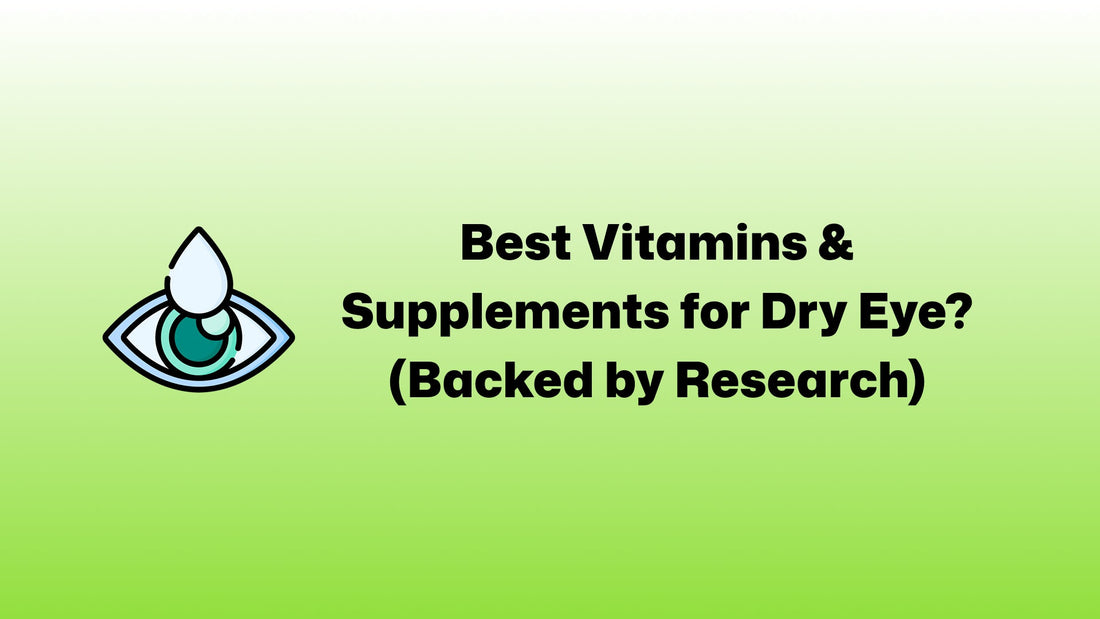
Best Vitamins & Supplements for Dry Eye? (Backed by Research)
Share
What is Dry Eye?
Dry eye is a clinically defined condition where the eyes fail to produce enough quality tears to keep the surface lubricated, clean, and comfortable. This imbalance in the tear film leads to persistent dryness, irritation, and sometimes blurred vision. The condition is not temporary and often worsens when left untreated.
There are two primary types of dry eye:
- Aqueous-deficient dry eye, where the lacrimal glands do not produce enough water.
- Evaporative dry eye, where the tear film breaks down too quickly due to poor oil production from meibomian glands.
In both types, the result is the same: the eyes become vulnerable to inflammation, friction, and external irritants. This condition directly affects quality of life, especially during reading, screen exposure, or driving.
What are the Causes of Dry Eye?
Dry eye is not caused by a single factor. It is the outcome of multiple contributing elements, often overlapping. Understanding these causes is essential before recommending any supplement or treatment.
Common contributing causes include:
- Aging, particularly after 50, when tear production naturally declines.
- Hormonal changes, especially in postmenopausal women.
- Environmental exposure, such as wind, smoke, or dry air.
- Long-term digital device use, leading to reduced blink frequency.
- Contact lens wear, which may disrupt the tear film.
- Systemic medications, including antihistamines, beta-blockers, and antidepressants.
Autoimmune conditions such as Sjögren's syndrome are also significant contributors, particularly when combined with other systemic inflammation indicators.
What are the Symptoms of Dry Eye?
Symptoms of dry eye are usually progressive. In early stages, they may be ignored or misattributed. However, once persistent, they can interfere with daily visual tasks.
Key symptoms include:
- A burning or stinging sensation in the eyes.
- Intermittent blurry vision that resolves after blinking.
- Feeling of sand or grit in the eye without any physical object present.
- Sensitivity to light, particularly outdoor glare or screen brightness.
- Eye fatigue after short periods of reading or computer use.
In more advanced cases, the eyes may paradoxically water excessively. This is not a sign of moisture, but a compensatory mechanism triggered by surface irritation.
Role of Nutrition in Dry Eye Syndrome
Nutrition affects every layer of the tear film. From lipid stability to mucosal immunity, several nutrients influence how tears are produced, maintained, and stabilized across the ocular surface.
Poor nutritional status may:
- Reduce tear quality, leading to faster evaporation.
- Impair mucin secretion, resulting in unstable tear distribution.
- Increase oxidative stress, promoting inflammation at the cellular level.
- Affect nerve function that stimulates tear reflexes.
Nutrition alone cannot replace medical treatment in severe cases, but evidence shows that in mild to moderate dry eye, dietary correction can meaningfully improve symptoms and reduce reliance on external lubrication.
Can Vitamin Deficiency Cause Dry Eye?
Yes. Several vitamin deficiencies correlate with changes in tear composition, quality, and ocular surface sensitivity. These deficiencies are not always clinically apparent but can significantly influence how dry eye develops and persists.
Common deficiencies associated with dry eye include:
- Vitamin A: Required for healthy epithelial cells and mucin secretion. Its deficiency directly leads to dry, keratinized ocular surfaces.
- Vitamin D: Plays an immune-regulatory role. Low serum levels are associated with increased tear osmolarity and ocular inflammation.
- Omega-3 Fatty Acids: Essential for lipid layer balance in the tear film.
- B Vitamins: Deficiencies in B2, B6, and B12 impact corneal nerve health and tear reflexes.
Correcting these deficiencies often leads to improvement in both subjective symptoms and objective clinical signs.
How Vitamins Help Relieve Dry Eye Symptoms
Vitamins support tear function at a cellular and biochemical level. They improve tear stability, reduce oxidative damage, and modulate the inflammation that underlies many cases of chronic dry eye.
Vitamins do not act instantly. Most clinical improvements are observed after consistent intake over several weeks.
Who Should Take Vitamins for Dry Eye?
Not every case of dry eye requires vitamin supplementation. However, certain groups are more likely to benefit from targeted nutritional support.
You may consider vitamins for dry eye if:
- Your diet lacks essential fats and fat-soluble vitamins.
- You are over the age of 50 with reduced tear volume.
- You experience symptoms despite using artificial tears regularly.
- You have autoimmune markers or systemic inflammation indicators.
- You take medications that impair nutrient absorption or tear secretion.
Best Vitamins for Dry Eye Relief Backed by Science
Omega-3 Fatty Acids
Omega-3 fatty acids support the oily layer of the tear film, helping reduce tear evaporation. They also lower inflammation in the glands around the eyes, which is a common cause of dry eye symptoms. People with meibomian gland dysfunction, a leading factor in evaporative dry eye, often benefit from omega-3 supplementation because it improves the quality and consistency of oil secretion.
Their anti-inflammatory effects help relieve burning and redness around the eyes, especially in individuals exposed to dry environments or screen-heavy routines.
Several studies suggest a potential link between omega-3 fatty acids and improved eye health. A survey found that women with the highest omega-3 intake from fish had a lower risk of dry eye, though the self-reported data limits certainty. Similarly, a study by Brigham and Women’s Hospital reported a 17% lower risk of dry eyes among participants consuming the most omega-3s. Additionally, research published in Investigative Ophthalmology & Visual Science showed that DHA, a type of omega-3, helped prevent age-related vision loss in mice.
Vitamin A
Vitamin A helps the eye maintain a smooth and stable surface by supporting mucin production. Mucin allows tears to spread evenly and stick to the surface of the eye, preventing dry spots. Without enough vitamin A, the conjunctiva may become dry and irritated, and the protective layer can break down.
Mild deficiencies can still impact eye comfort, even if vision remains unaffected. This is particularly relevant in low-fat diets or people with limited intake of dairy or leafy vegetables.
Vitamin A plays a key role in maintaining the ocular surface, supporting the growth and differentiation of corneal and conjunctival epithelial cells. In a 2019 study, participants with dry eye who took 5,000 IU of oral vitamin A daily for three days reported improved tear quality.
Vitamin D
Vitamin D plays a regulatory role in the immune system. Low levels are linked to higher ocular surface inflammation, which is a core mechanism in chronic dry eye. People with vitamin D deficiency often report eye discomfort, especially during allergy seasons or when exposed to dry air.
Vitamin D helps reduce inflammatory signals in the eye and supports normal tear production. It is particularly helpful in patients who don’t respond fully to artificial tears alone.
Several studies suggest that supplementation may reduce ocular surface inflammation and enhance the effectiveness of lubricating eye drops. Research from 2018 and 2019 showed that oral vitamin D improved tear quality and dry eye symptoms. A systematic review published in Ophthalmology 360 found that patients with dry eye had significantly lower serum vitamin D levels compared to controls. These patients also showed worse symptom scores and reduced tear production, indicating that vitamin D deficiency may be a risk factor for dry eye syndrome.
Vitamin E
Vitamin E acts as an antioxidant. It protects the eyes from oxidative damage caused by pollution, UV exposure, and prolonged screen use. While it doesn’t directly increase tear production, it helps preserve the quality of the tear film by stabilizing the cell membranes of the glands that produce tears.
When used together with omega-3 fatty acids, vitamin E can improve the stability of the lipid layer in the tear film and reduce oxidative stress on the ocular surface.
Studies suggest that vitamin deficiencies are linked to a higher risk of dry eye, and supplementation can improve symptoms in patients with confirmed deficiencies. In one study, eye drops containing 0.1% cross-linked hyaluronic acid, coenzyme Q10, and vitamin E were as effective as higher-dose carmellose drops in improving tear film stability in menopausal women on antidepressants. Similar benefits were observed in pediatric patients and individuals exposed to chlorinated water, supporting the potential role of topical vitamin E in restoring ocular surface homeostasis.
B Vitamins
B vitamins, especially B2 (riboflavin), B6, and B12, are essential for the health of the corneal nerves and tear reflex pathways. Deficiency in these vitamins may not always affect vision directly but can lead to eye discomfort, sensitivity to light, and reduced blink efficiency, which are all contributors to dry eye symptoms.
Vitamin B12, in particular, supports corneal nerve regeneration. This helps restore natural tear production and reduce pain in people with neuropathic eye discomfort.
A 2020 study involving 76 participants found that combining oral vitamin B12 supplements with artificial tears improved dry eye symptoms. Other studies suggest that B12 may help reduce the burning sensation associated with nerve damage in dry eye cases.
When Are Vitamins Not Enough for Dry Eye?
Vitamins are supportive, not curative, especially in advanced or complex cases of dry eye. There are situations where supplementation alone will not result in meaningful improvement.
Vitamins are not enough when:
- The tear glands are structurally damaged or atrophic.
- There is significant meibomian gland dropout.
- The cause is mechanical (e.g., eyelid malposition).
- Autoimmune diseases are actively attacking tear-producing tissues.
- The patient is non-responsive to both artificial tears and anti-inflammatory therapy.
In such cases, vitamins may still be used as adjuncts but should not delay medical intervention. Proper diagnosis through tear film tests, meibography, and ocular surface staining remains essential.
